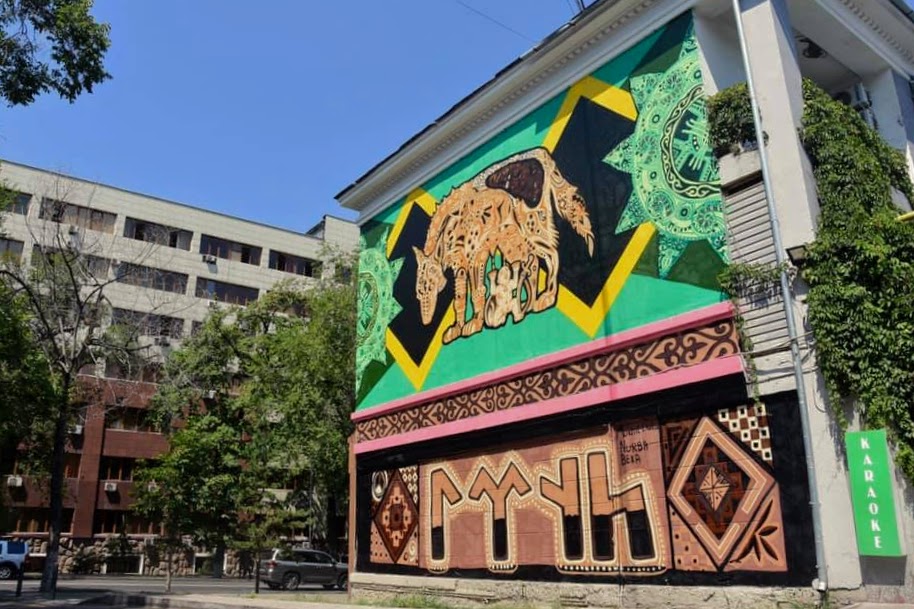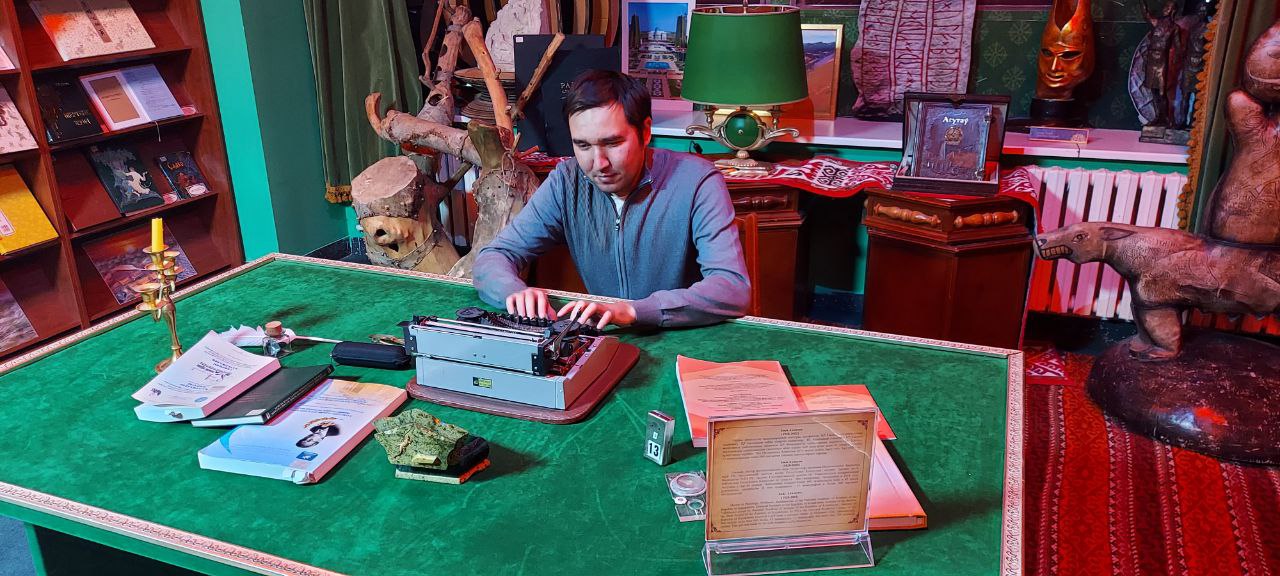Tengrism is called by the media either as a religion or the philosophy of nomads. The number of Tengrian gods is also a ‘variable component’, which changes from article to article. Who are modern Tengrians, what they believe in, and how they differ from their steppe ancestry is explained in the material of CABAR.asia.

“We might never know what was real Tengrism like [because] we deal only with the rudiments of what could be called the Tengrism,” this is how the Kazakhstan-based philosopher and writer Auezkhan Kodar explained why the traditional belief of nomads has several definitions.
He wrote that nomads were cosmological: they did not separate themselves from the universe and Tengri (the supreme deity) was almost the same part of it as they were. They needed god not as the explanation of the origin of the universe, but as the mighty power that keeps the hierarchical order.
“The nomad does not have constant need in God, they have it once they have problems. Therefore, nomadic communities do not have one worship, one tribe could have one prevailing deity, and the other one could have another,” Auezkhan Kodar explained.
According to him, nomads could turn not to Tengri directly to solve their problems, but to the spirits of a certain place. Besides, nomads believes in aruakh – spirits of the ancestry. To get help of the aruakh, no prayers were needed, it was enough to be filled with their spirit. In other words, “the main peculiarity of the Tengrism is that it does not have a special army of religious workers and that it cannot do without local peculiarities.”
These “local peculiarities” can be seen even in one Almaty, whose residents are Yerlan Yespenbetov, the Tengrian, director of the Centre for Turkic Runic writing Kaganica, as well as Nurkozha Yersaiyn, historian, public figure and Tengrism researcher.
According to Yerlan Yespenbetov, the Turks were the people living in the vast area from Yakutia to Turkiye. In the times of the Turkic Khaganate, which occupied the most part of the area, Tengrism was the state ideology, and the Turks automatically became the followers of the Tengrism.

The point of this ideology, according to Yespenbetov, was that a human must develop and make decisions with respect to the nature and the ancestry. The responsibility before the kindred is fundamental for moral guidelines: the Tengrians have no paradise and hell, yet they fear to displease their ancestry and have the curse to the seventh generation.
According to Nurkozha Yersaiyn, the Tengrism emerged approximately in the Stone Age and became the religion of nomads.
“There is one god in the Tengrism, and it’s nature,” Yersaiyn said. “This is the absolute, this is the whole universe with all its laws of physics, karma, etc.”
There are laws of Gods in the Abrahamic religions, which can be broken. “In the Tengrism, you cannot break any laws because God’s laws sound like this, “If you throw up an apple, it will fall down,” Yersaiyn said. “If we speak about homicide and similar things, it is now considered the law of the universe: if you do something wrong, it will come back to you. If not to you, then to your descendants.”
According to Yerlan Yespenbetov, because Kazakhstan has long been a part of the Communist country, very little information is known about the Tengrism. But in villages, traditions have been passed down on through generations. And today many Kazakhs are not even aware that they keep to the Tengrism. For example, when they smoke the house with adyraspan (a local name for the peganum. The smoke of the burnt plant is considered to ward off the evil spirits and bring luck – Editor) or wear the tumar (a Kazakh national talisman in the shape of a triangular ‘bag’ made of leather or silver with the lines from the Quran inside – Editor).
The influence of the Islam, according to Nurkozha Yersaiyn, is one of the main distinctions of the modern Tengrism from nomadic beliefs.
“Many documents indicate that the Kazakhs have never worshipped anyone, yet their rulers, when they wrote to other Muslim rulers, wrote something like this, “We, the Muslims, are brothers.” The rulers definitely stuck to Islam, but it was not as strong as it is now among the people. Now the Islam is thriving in Kazakhstan, it has become a part of the national identity once the Union collapsed,” the historian said.
But now those who sought support in the Islam get disappointed, said Nurkozha Yersaiyn, and the cancel culture takes its place:
“Some people have a negative image of the Islam because of terrorism and Muslims who impose their views on others. The very same Nurtas Adambai (a Kazakhstan-based actor practising Islam has managed to ban showing of Buzz Lightyear film as he saw the propaganda of LGBT there – Editor) behaves foolishly by banning movies. I know young men who do not want to be a part of such an Islamic world. But it’s difficult for them to become atheists.”
So, those who do not care about identifying themselves with any specific ethnicity are interested in mantras, chakra breathing and similar practices. “Tengrism is a perfect thing for those who want to remain a Kazakh (identify oneself with Kazakhs – Editor), ‘I am neither a bad man, nor an atheist, or heretic, and I believe in what my ancestry believed in.’ It also supports the national identity,” Yersaiyn said.
Since ex-Muslims come to the Tengrism, they take everything through the prism of Islam, look for analogues of Islamic concepts in the Tengrism, and argue whether it came with the Islam or it was original, Nurkozha Yersaiyn said.
Followers of other Abrahamic religions, who are used to religions with strict structure and rules, try to find the same in the Tengrism. But it does not have it.

“Everything was simple in the past: there is the Tengri (the heavenly god – Editor), who is everywhere, and everything exists according to its rules. And now there are so many different gods like Umai (the goddess of fertility – Editor), Erlik (the ruler of the kingdom of the dead – Editor). These gods come from Tibet, China, and other places. Some recognise them, some don’t,” Nurkozha Yersaiyn said.
Urban life has its impact, too. Thousands of years ago, Tengrians gathered in the steppes to honour the new sun born after the longest night of the year, the celebration of the winter solstice, Nartugan.
“Now some go out to the steppes, some light bonfires, but more often people meet at the restaurant and drink,” Yersaiyn said.
He also pointed out that the Tengrism has turned into a subculture or a cosplay fan club rather than a lifestyle. “This is the paradox as the Tengrism has originally been the belief in the steppe, and now it revives in cities.”
Another paradox is that the Tengrism has become the religion of the intelligentsia from the people’s religion. According to Yerlan Yespenbetov, the Tengrian society of Kazakhstan has many scholars, musicians, artists, teachers and businesspersons. They often know several languages, and have more than one degree. They accept and respect other faiths and cultures, yet they do not like when something is imposed on them.
“We strive to keep traditional rites and rituals. We do not ignore the modern world, yet we take what does not damage the Tengrism,” Yespenbetov said. “The Tengrians, whom I know, live modestly, by conscience, regardless of their office. They do not take bribes not because they are afraid of imprisonment, but not to call down the wrath of their ancestry.”
The modern Tengrism has many directions, said Nurkozha Yersaiyn. Because there is no single figure, like the Pope or imam, in the Tengrism, those who have studied the Tengrism for a long time come to a ‘more appropriate’ option of faith and gather other like-minded persons.
“There are 3-4 groups like that in Almaty,” Nurkozha Yersaiyn said. “They meet separately, the only common thing they have is that all their meetings are held in Russian.”
The total number of the Tengrians in Kazakhstan, according to the historian, is not more than 2 per cent of the population (or almost 395 thousand out of 19.7 million citizens of Kazakhstan, according to official data). Over 90 per cent of them, according to him, live in Almaty. Yerlan Yespenbetov called other numbers: the official number of Tengrians in the country is nearly 58 thousand (the Bureau for National Statistics did not provide data on the Tengrians – Editor), but the unofficial number is more than a million. The reason for such difference in numbers is that not all people who consider themselves Tengrians are willing to speak about it openly.
“Most of Tengrians are latent. They hide because it could be dangerous: now people in mosques actively use anti-propaganda and say that Tengrians are misguided people, although they did not know about them just five years ago. Many Tengrians are young people. And they fear to tell about it to their Muslim parents. If a person says among average Kazakhs, “I am a Tengrian,” he would immediately face preachment and the attitude towards him could change,” Nurkozha Yersaiyn said.
Nevertheless, according to him, some followers want the Tengrism become the state religion. Others stand against it because the philosophy of the steppes must remain the philosophy of the steppes.

